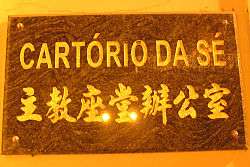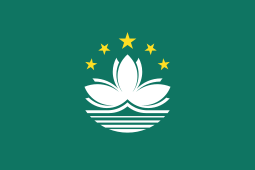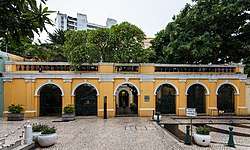Culture of Macau
Macau is an autonomous territory within China. A Portuguese colony until 1999, Macau has a diverse culture firmly rooted in Cantonese culture, with a mix of influences from East Asia and Western Europe. Macau is known for being the largest gambling center in the world.

| Part of a series on the |
| Culture of Macau |
|---|
 |
| History |
|
People |
| Languages |
| Cuisine |
|
Festivals |
| Religion |
|
Music and performing arts |
|
Media
|
| Sport |
|
Symbols
|
People and languages
The two official languages of Macau are Chinese and Portuguese, although the latter is only spoken by a small minority. English is also widely spoken.
The Macanese language, generally known as Patuá, is a distinctive creole that is still spoken by several dozen members of the Macanese people, an ethnic group of mixed Asian and Portuguese ancestry that accounts for a small percentage of Macau's population.
Signs in Macau are displayed in both Traditional Chinese and Portuguese. In contrast to mainland China, Macau—along with Hong Kong and Taiwan—generally does not use Simplified Chinese characters.
Among the main migrants of the country are skilled workers from the Philippines, hence Tagalog is one of the most-heard foreign languages.
Cultural identity
The worldwide popularity of Cantonese food and Chinese martial arts (kung fu in Cantonese or wu shu in Mandarin) has made them popular in Portugal as well.
In 1998, the first Festival da Lusofonia took place in Macau, a festival of Portuguese-speaking communities. In November 2013, the 16th edition of the festival took place over the duration of two and a half days with musical activities, kids programmes, traditional Portuguese games and food from Portuguese-speaking countries' cuisines.[1]
Mass media
Most of the pop music that can be heard on the channel TDM Teledifusão de Macau (澳廣視)[2] is imported from Hong Kong or overseas (mainly Japan). However, more and more local songs are being recorded by locals. Some Brazilian TV stations are also broadcast in Macau.
Cuisine
Macanese cuisine is a blend of southern Chinese (especially Cantonese cuisine) and Portuguese cuisines, with significant influences from Southeast Asia and the Lusophone world. The most famous snack is the Portuguese-style egg tart. It is widely popular in Southeast Asia, especially in Taiwan and Hong Kong. The most famous Macanese food is Galinha à portuguesa which is served in numerous varieties in Macau restaurants.
Religion
The primary religion is Buddhism. Roman Catholicism has considerable influence in education and social welfare in Macau. However, adherents only count for about six percent of the population. Protestantism is spreading quickly, especially among the younger demographic groups.
Chinese traditional medicine
The practice of traditional Chinese medicine is an inalienable part of culture in the sphere of medical education, and a very common, alternative, and popular choice of treatment in Macau, for people of all social classes. With over 90 percent of its population having Chinese ancestry, Macau has had a long history of using Chinese medicine.
A Pan-Pearl River Delta Forum and Exhibition for Chinese Medicine was held in Macau from June 21 to 23, 2005, intended to further Macau's ambitions of becoming a means of access to Chinese traditional medicine for the international market.
Arts

Film
A few independent films have been produced since the late 1990s. Some of the well-known productions include:
Music
The Macau International Music Festival is conducted by the Cultural Affairs Bureau of the Macau SAR Government every autumn.[5] The 20th anniversary of the MIMF was celebrated in 2007 with performances of Jazz, classical music, electronica, Chinese folk-pop, rock and Fado.[6]
Other Lusophone music types popular in Macao are samba, bossa nova, and kizomba.[7]
In 2005, the Hush!! Full Band Festival got established, a government-sponsored modern music festival featuring pop rock and hard rock bands from all over Asia with a focus on Macau bands. The festival is free of charge and it's in its 9th edition in 2013.[8]
Literature

The literature of Macanese (i.e. those with Portuguese descent) is a multi-dimensional art. Their literature appeared as early as the 19th century. At the beginning of the 20th century, a group of well-known writers appeared:
- 李安樂的詩集《孤獨之路》 – Anthology "Lonely Road", 《美麗的蛋家女》(TancareiraBela),《沉思的蛋家女》(Tancareira Pensativa)及《蛋家女之歌》(CancāoDe Tancareira) – Leanel Alves.
- 若瑟(阿德)的詩集《澳門,受祝福的花園》 – Anthology "Blessed garden, Macau" – Jose dos Santos Ferreira.
- 江道蓮的短篇小說集《長衫》 – Short fiction: "The Gown" written by Deolinda de Conceição[9]
- 飛歷奇的長篇小說《愛情與小脚趾》和《大辫子的誘惑》 – Long fiction: "Love and small toes" & "The Bewitching Braid" written by Henrique de Senna Fernandes[10]
- 馬若龍的詩集《一日中的四季》 – Anthology "Four seasons in one day" – Carlos Marreiros[11]
- Other:
- "Chinese Urheen – 《中國二胡》" Camilo Pessanha (庇山耶) 1867–1926
- "Collection of Cathedral of Saint Paul -《三巴集》" WuLi (清代 • 吳曆) 1632–1718
- Renowned playwright Tang Xianzu[12] (明代 • 湯顯祖 1550–1616). His works covered "XiangAo Meets Jia Hu" – 《香澳逢賈胡》,"Listens to Xiangshan – Translator" one, "Listens to Xiangshan – Translator" two – 《聼香山譯者 1, 2 》, 《香山驗香所採香口號》, "South Haijiang" – 《南海江》 and so on. These works mainly reflected and depicted Macau's local scenery at that time (late Ming dynasty), the human sentiment and international trade.
- "The Chart of Maritime Countries – 《海國圖志》", "Listens to the Dulcimer & Song playing by a foreign lady in the Aomen Garden – 《澳门花园听夷女洋琴歌》" written by WeiYuan (清代 • 魏源 1794–1857), displayed his personal feeling and understanding of classical music.
Cantonese Opera
Cantonese Opera[13] is quite popular, especially among elderly residents. In 2003, the Cultural Institute of the Macau S.A.R Government, in collaboration with the Leisure and Cultural Services Department of the Hong Kong SAR, organized the exhibition "Fong Yim Fun – The Life and Work of a Cantonese Opera Artiste".[14] As a well-known actress and opera artiste in Canton, Hong Kong and Macau, Fong Yim Fun performed in more than 150 operas and films. Part of her works was exhibited in the Museum of Macau at that time.
Facilities
The Macao Cultural Centre was established in 1999, for the purpose of offering unique venues for artistic events, international conferences and exhibitions, enhancing cultural exchange, and helping to expand culture horizons among Macau residents. Hundreds of programs and events take place there almost every day—e.g., martial arts performances, Chinese traditional music, foreign music, varies types of dancing, etc.
The Macau Ricci Institute is a recent foundation of the Jesuits in Macau. Its aim is to continue the process of friendly encounters between Chinese and Western cultures and traditions, which was begun by Matteo Ricci 1552–1610 many years ago.[15]
References
- Instituto Para Os Assuntos Civicos E Minicipais (IACM) (2013-10-11). "16º Festival da Lusofonia". Archived from the original on 2013-11-04. Retrieved 2013-11-03.
- "Macau TDM". Portugues.tdm.com.mo. Retrieved 29 January 2018.
- "macau.xmas.2005". Macau-creatives.org. Archived from the original on 27 May 2016. Retrieved 29 January 2018.
- "Home". Diffproductions.com. Retrieved 29 January 2018.
- "17th Macau International Music Festival". Instituto Cultural do Governo da R.A.E. de Macau. Archived from the original on 2007-09-27. Retrieved 2007-06-01.
- "20th MACAU INTERNATIONAL MUSIC FESTIVAL". Travelscopy.com. Retrieved 2007-06-01.
- "20th Macau International Music Festival - Traveloscopy". Traveloscopy.com. Retrieved 29 January 2018.
- "HUSH!! Full Band 馬拉松搖滾音樂祭2013". Ccm.gov.mo. Retrieved 2013-10-28.
- "Introduction". Arscives.com. Retrieved 29 January 2018.
- "Archived copy". Archived from the original on 2007-09-29. Retrieved 2006-08-28.CS1 maint: archived copy as title (link)
- "Carlos Marreiros". Dinastia Macau (in Portuguese). Imprensa Oficial. Archived from the original on 2006-05-12. Retrieved 2006-08-28.
- "Tang Xianzu". renditions.org. Archived from the original on 2001-05-22. Retrieved 2005-07-24.
- "Cantonese Opera to be proposed for World Heritage", Macau Heritage Net, 2002-11-21, archived from the original on 2004-10-27
- "Fong Yim Fun - The Life and Work of a Cantonese Opera Artiste". Museum of Macau. Archived from the original on 2006-01-08. Retrieved 2006-08-28.
- "The Macau Ricci Institute - Macau Ricci Institute Studies". Archived from the original on 2005-10-27.
External links
- HUSH!! Full Band Festival, official CCM website
- Macau scene overview at RockinChina.com